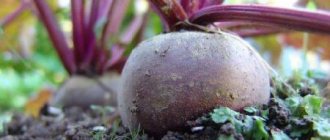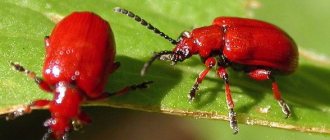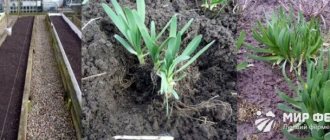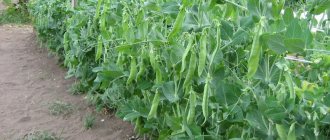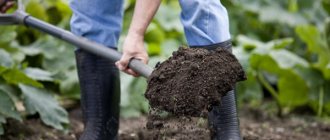Beet diseases are not very pronounced and often go unnoticed for a long time. At the same time, harmless-looking spots on the tops can destroy a considerable part of the crop, and significantly reduce the shelf life of the remaining root crops. But you can only see the damage caused in the fall or after storing it for winter storage. Therefore, it is necessary to take preventive and therapeutic measures at the earliest stages. To do this, you need to look at what beet diseases look like in the photo in order to recognize the first signs in time.
Diseases of table, sugar and fodder beets, as well as common pests
The trouble is that not every disease can be immediately identified by the appearance of beets when storing them - sometimes the core of root crops imperceptibly rots or internal voids form. You will discover an unpleasant surprise after you cut the beets, and in the meantime the infection will have time to spread to healthy root vegetables.
Main diseases of table beet, sugar and fodder
In order for the beet harvest to be safely stored in the cellar or on the balcony until spring, it is necessary to select only high-quality, healthy root crops, because beet diseases can quickly spread and leave you without vegetables for the winter.
That is why it is so important to pay attention to preventive measures and timely control of various beet diseases and pests.
Video about sugar beet diseases
Preventative measures for beet diseases:
- planting disease-tolerant varieties,
- feeding beets with fertilizers,
- correct agricultural technology,
- timely harvesting,
- careful inspection of plants during the growing season and root crops before sending them for storage.
Weakened plants get sick much more often, so be sure to periodically fertilize with phosphorus and potassium, complex fertilizers with various microelements, and add rotted organic matter to the beds.
In the photo there are beets
Fomoz
Lack of boron in the soil contributes to beet blight (zonal spotting). The fungal disease appears in the form of brownish or yellowish spots of concentric shape on the surface of the lower leaves, and later black dots also appear. With Phoma, the affected leaves and shoots of the testes die, dry rot of the beet heart develops - when you cut the root crop, you will see dark brown tissue.
Phoma develops most quickly during frequent drizzling rains, fogs, high air humidity and heavy dew at moderate temperatures. Spreads by spores in rainy, windy weather. The causative agent of phomosis persists in the testes, on seeds and on affected plant debris.
The addition of borax to the soil, as well as the treatment of root crops with solutions of Fundazol, Benazol, Rovral, TMTD before storage, helps to protect beets from fomosis.
In the photo, fomoz in beets
Cercospora
Up to 70% of the root crop harvest can be lost due to a common disease such as beet cercospora blight or spot. Infection of leaves by the pathogen leads to their death and deterioration in the keeping quality of root crops. The disease can be identified by small light spots appearing on the leaves, bordered by a reddish stripe, and by a light gray coating on the underside of the leaves. Young leaves are not affected by the disease, but old leaves gradually turn black and begin to die. Instead, beets grow new leaves, using up nutrients that should have been used to form root crops.
The causative agent of the disease overwinters in plant debris and perennial weeds. Beet cercospora develops at +16+20 degrees and with excess soil moisture.
Measures to combat cercospora: growing beets after predecessors that are resistant to this disease, choosing tolerant beet varieties, weed control and destruction of plant debris, treating seeds with Agat-25 and spraying plantings with Rovral fungicide.
Photo of cercospora blight on beet leaves
Downy mildew
In humid, cool weather, beets are often affected by downy mildew, also known as downy mildew. With this disease, a grayish-purple coating appears on the underside of the leaves, the leaf blades curl downwards at the edges, turn pale, crumble and dry out in hot weather, or rot from dampness. The affected shoots of the testes are also covered with plaque, deformed and die. Collected root vegetables quickly begin to rot during storage.
To protect beets from downy mildew, you need to pay attention to crop rotation, harvesting plant residues, treat the seeds before sowing with Apron and spray the plants with fungicides during the growing season.
Corneater
In the photo there are beets
Judging by the name, you might think that we are talking about a pest, but the root beetle is an infectious disease that causes damage to young beet seedlings. First, the stems at the seedlings turn black and become thin, and then die. Seedlings affected by infection also die without even reaching the soil surface.
Typically, the root beetle spreads on heavy soils, in lowlands, in patches throughout the area. Lack of aeration, crust on the soil surface and increased soil acidity contribute to the spread of infection.
For prevention, it is recommended to lim the soil in the fall, add a borax solution to the soil before sowing in the spring, and mulch the sown seeds with peat or humus. And don’t forget to loosen the row spacing to prevent crust formation.
Rotten
The photo shows beets affected by rot
At the beginning of summer, there is a high risk of beets being damaged by fusarium rot, especially if the plants were damaged during loosening or weakened by drought. With fusarium, the lower leaves of young beets wither, the petioles turn black at the very base, and side roots form on the root. If you dig up a root crop, you can see cracks in it filled with white plaque.
In mid-summer, the tail part of the beet root is affected by brown rot. It spreads when there is excess moisture or excess nitrogen in the soil. With severe damage, a brown felt coating appears on the beet petioles and begins to spread along the surface of the soil.
To protect beets from fusarium and brown rot, you need to feed the plantings with organic and mineral fertilizers containing boron, lime acidic soils, deeply loosen the rows on heavily moist soils, alternate crops and control pests. Affected plants must be immediately removed from the garden and burned.
Video about the problems of diseases on sugar beets
Common beet pests
Incorrect agricultural technology, especially untimely destruction of weeds in beet beds and failure to observe crop rotation, leads to beets being damaged by various pests. The most common are the following:
- beet fly - damage is caused by yellow larvae, eating away wide passages in beet leaves;
- leaf miner - it also “makes holes” in the leaves, but its larvae are white;
- beet aphid - located on the lower part of beet leaves and sucks the juice from them, preventing the development of the entire plant;
- beet flea beetle - its white half-centimeter larvae feed on beet roots;
- Beet bug - a bug-like beetle that damages young beet seedlings and eats holes in the leaves of adult plants.
In the photo there is a beet aphid
You can rid your beet plantings of most of these pests by regularly destroying weeds and not allowing them to grow nearby. To prevent beet aphids, beets can be sprayed with an infusion of onion peels and ladybugs can be spread on the plantings; spraying plants with Iskra Bio also helps against aphids. Beet fly and leaf miner can be controlled by treating beets with Iskra or Golden Iskra, as well as karbofos. Treating beet beds with an infusion of ash or sprinkling with tobacco dust is considered an effective remedy against flea beetles. You can also get rid of beet pests with the help of deep autumn digging of the beds.
orchardo.ru
Potato scab. How to deal with scab on potatoes and cure the soil
Scab is one of the most common fungal infections of potatoes. The disease spoils not only the appearance of the tubers. Taste quality deteriorates and storage is reduced. Fungal spores quickly multiply and capture more and more plants, so it’s worth understanding the reasons for its appearance and learning how to get rid of scab on potatoes. Photos and descriptions of scab types will help to more accurately diagnose the disease and take effective measures in time.
Outwardly, it resembles scabs on tubers. The lesion begins with small ulcers - if you do not pay attention to them in time, the disease reaches an extreme degree of manifestation - the appearance of deep cracks with torn edges. Bacteria develop in such tubers and the potatoes rot.
Spread of the disease
The disease mainly affects tubers and rarely spreads to tops and roots.
The fungus spreads by spores from one bush to another and gradually takes over the entire field if measures are not taken in time. The spores survive in the ground for up to three years, which is why it is so important to change the planting site.
The fungus can be spread by using fresh organic matter: scab spores remain viable after passing through the animal’s digestive tract. The cause of the disease may be incomplete disposal of infected potato tops in the fall.
During potato growth, it is impossible to notice scab, so it is important to take into account the presence of fungus on tubers during harvest and take preventive measures for the next year.
Causes of potato infection
The main reasons for crop damage:
- non-compliance with crop rotation - it is important to change the planting site at least once every three years;
- planting affected tubers;
- hot (25-30°C) dry weather promotes the growth of fungus;
- improper application of organic fertilizers;
- weak soil acidity;
- improperly equipped potato storage facility - elevated temperatures and humidity, large volume of potatoes with poor ventilation.
Reference. Loamy and sandy loam soils are more susceptible to scab. Before planting, the tubers must be pickled. Plant potatoes deeper to prevent excess oxygen.
How does scab appear on potatoes?
There are several varieties of scab depending on the color, shape and signs of the lesion.
Ordinary
Spots on tubers in the form of hard sores with a dry rim of dark yellow or brown color.
They can cover entire potatoes or individual areas. Common scab occurs due to shallow planting and access of air to the tubers, due to improper application of lime and wood ash to the soil. It manifests itself in soils poor in moisture. Spores enter the tuber through mechanical damage to the skin. Varieties with red thin skin are often affected by the fungus. The affected vegetable is poor in minerals, vitamins and amino acids.
Silver
A distinctive feature is its appearance in the form of silvery spots. First, brown spots or spots that look like black soot form. When the skin peels off, a gray spot appears in its place. The tuber becomes wrinkled. The size of the spot can cover up to 40% of the entire tuber.
This type of fungus dries out the tops, which leads to early death of the entire plant, softens the affected tuber, drying it out. The taste of such potatoes is unpleasant and they are not suitable for planting. The development of the fungus begins at a temperature of +3°C and high humidity (80-90%).
Silver scab
Powdery
The symptom is small focal growths on the stem. The tubers have white growths that turn brown over time. The ulcers contain brown dust from fungal spores and remnants of tuber tissue. Subsequently, the potatoes rot.
Sources of the disease are contaminated planting material, manure, humus, chicken droppings. Another reason is the soil is too wet. This type of scab affects the roots and stems of vegetables. Tubers become susceptible to late blight and dry rot.
Powdery scab
Black, or rhizoctonia
It develops at high humidity and affects the plant from the tuber to the leaves. This type of fungus looks like black loose spots, similar to stuck lumps of earth. Cover the tuber in small areas no more than 5 mm in girth. If the disease becomes active in the early stages of plant development, it can destroy the entire bush.
Tubers are poorly stored, rot does not develop deeply, but often other types of rot form on it, which completely destroys the crop. Early detection of potato rhizoctonia will help start treatment on time.
Rhizoctoniosis (black scab)
Tuberous
Only tubers are affected - tubercles appear, which then turn into pits with putrefactive contents. It appears most clearly in the third or fourth month of storage. Poorly dried tubers suffer the most.
Lumpy scab
How to deal with scab
There are many methods to combat scab - folk recipes, chemicals and biological methods.
Beet diseases and their control: photos and descriptions
Table beets are rightfully considered an unpretentious garden crop, which even a beginner can grow.
But sometimes strong, healthy tops become covered with reddish and brown spots, the leaves curl and dry out, and the development of root crops is suspended. In this case, even experienced plant growers have questions. Why do the leaves turn yellow and the beets grow poorly? As experts say, the tops can be used to judge the condition of the entire plant. There may be several reasons for the deterioration in the health of garden beets. These include overly acidic or saturated soils, lack of minerals and nutrients, and interruptions in watering. Unfortunately, it is possible that the plants were attacked by fungi that cause beet diseases, the leaves of which were the first to react to infection. At the same time, the appearance of root crops before they go into storage may not suffer, but in winter you can lose the entire crop.
Descriptions and photos of beet diseases, as well as methods of combating them, will help you notice dangerous symptoms in time, begin treating plants and master the simplest methods of prevention.
Fomoz: disease of beet leaves and its roots
A disease of beet leaves, accompanied by the appearance of yellowish or brown round spots on the leaf blades, often with a concentric pattern, is called phomosis, heart rot or zonal spot.
The disease spreads from the lower leaves, which die due to rapidly developing foci of infection. If the disease overtakes the beets in the second year of life, the peduncle also dies, and the root crop itself, if stored, very soon rots. Why do beet leaves turn yellow, and what to do to stop the process and not lose the harvest?
The development of the disease is favored by cool, rainy weather, as well as heavy dew in the second half of summer, when night temperatures are already quite low. With gusts of rain and wind, spores of the harmful fungus are spread throughout the plantation, and the causative agent of the dangerous beet leaf disease waits out the winter in dead foliage left in the garden bed, on affected root crops and even on seeds.
It has been noted that a lack of boron in the soil contributes to the appearance of the disease, and the timely application of this microelement, for example in the form of borax, will serve as both a good preventive measure and a means of combating the disease.
Methods of control and prevention:
- Treating seeds and root crops with Fundazol helps protect beds from the Phoma pathogen.
- During the last growing season, beet plants are fertilized with products containing potassium.
- We must not forget about observing the rules of crop rotation, timely weeding of beet rows and thinning the seedlings.
- All fallen plant debris from the beds is removed and burned.
If the disease has already made itself felt on the site, the plantings must be treated with Fundazol or other systemic fungicides. Beets sent to storage are regularly sorted, rejecting rotten and soft root crops, after which containers for vegetables are disinfected and dried.
Beet cercospora: what to do if the leaves turn red?
Gardeners looking for an answer to the question: “Why do the leaves on beets turn red, and how to deal with this problem?” most often encounter the manifestation of cercospora.
The disease is caused by fungal pathogens and is detected by first reddish and then light-colored spots in the center with a purple or burgundy border that appear on the foliage. If you look at the back of the affected leaf, you will notice a light gray coating. The lower, adult leaves on the rosette are attacked. Gradually the number of spots increases. The size of the foci of this disease of beet leaves grows, and the drying tissue in the center is destroyed.
Plants susceptible to cercospora blight weaken because diseased leaves die, and beets spend energy not on the formation of root crops, but on renewing the above-ground green part.
Without effective measures to combat beet disease, the proliferation of a harmful fungus reduces the yield by almost half. Fodder and sugar beets are especially affected. The causative agent of cercospora blight is most active in rainy weather at temperatures above +16 °C; the fungal spores overwinter on the stems and root zone of perennial weeds, as well as on plant litter that has not been removed from the beds.
The following measures are taken to combat the development of the disease:
- preliminary seed treatment;
- selection of beet leaf disease-resistant varieties and hybrids;
- Spraying with products containing copper preparations every 7–10 days;
- thinning of seedlings at the 2–3 leaf stage;
- regular weeding of beds and removal of dead leaves;
- selection of a site for sowing, taking into account previous plantings;
- spraying existing plantings with a fungicide.
Beet ramulariasis
The spotting of beet leaves that occurs when plants are infected with ramulariasis resembles that which develops with cercospora blight.
However, there are still differences in this beet leaf disease. The foci of the disease in this case are lighter, at first even brown-green, and small, reaching a maximum diameter of 1.5 cm. But even inside such small spots, the tissue of the leaf blade dries out, dies and is destroyed. The crimson or brown border is vague. The disease ramulariasis makes itself felt in the second half of summer. The first spots can be seen on the lower leaves, and then the disease spreads to the young tops and petioles.
What to do if the beet leaves turn red and spots signaling ramularia appear on their leaves? Since the pathogen can overwinter even on roots and seeds, ramulariasis is observed on seedlings, as well as on peduncles. The fungus develops in a humid environment at low positive temperatures, causing large losses in the yield of fodder beets, as well as other types of cultivated plants. The fight against beet disease includes both preventive measures and treatment with systemic fungicidal preparations, as in the case of cercospora.
Downy mildew: what to do and why beet leaves turn yellow
Downy mildew or downy mildew also affects beets in wet weather and is accompanied by yellowing, and then curling and dying of leaf blades.
Why do beet leaves turn yellow, and what to do if this disease affects garden beds? The cause of the death of foliage is a harmful fungus, whose spread and reproduction can be seen on the tops covered with brown drying or rotting spots. On the back side, a gray or purple coating is clearly visible. These are spores of a fungus ready for further expansion. You can protect crops from peronosporosis:
- dressing the seeds of this crop before planting in the soil;
- removing plant residues during the growing season and after harvesting;
- spraying plants with fungicides.
Periodic treatment of plantings with Bordeaux mixture can be considered an effective measure to combat beet leaf disease.
Fusarium: a disease of beet leaves and root crops
If a gardener notices that the lower leaves of young plants turn yellow, discolored and wither along with the petioles for no apparent reason, this cannot but cause alarm.
Why are the leaves yellow and beets growing poorly in this case? Perhaps the beets in the garden are infected with fusarium. The disease, which begins with beet leaves, affects not only the tops, but also the root crops. As the disease develops, the foliage rots or dries out, and the fungus penetrates into the tissue of the rhizome, as evidenced by the mycelium visible on the cut root. Why do the leaves turn yellow, and what to do with beets already affected by the disease? Unlike other beet diseases, fusarium spreads from the root up the plant and can lead to its death.
The beet disease, as in the photo, causes the greatest harm to plantings that lack watering, as well as to beets damaged during hilling or weeding.
Measures to protect beets from fusarium blight include:
- fertilizing with mineral and organic fertilizers, paying attention to products containing boron;
- liming of acidic soils;
- compliance with the rules for alternating garden crops during crop rotation;
- deep loosening of soil between rows;
- regular and sufficient watering;
- weed and pest control.
Beet plants affected by rot are removed and destroyed so that the infection does not affect neighboring plants.
Preventive measures for beet diseases
The danger of beet diseases and the need for effective measures to combat them is due to the fact that the external manifestations of these diseases in the form of redness or yellowing of leaves do not always equate to true damage.
Cavities and rot inside root crops are discovered only during storage, when most of the beets are wasted. Preventive measures are extremely important to prevent the fungi that cause diseases of beet leaves and root crops from having the slightest chance to gain a foothold and develop.
To this end:
- select hybrids and varieties resistant to fungal diseases;
- follow the agricultural practices for growing beets, including weeding, thinning out thickened seedlings and maintaining clean soil under plantings;
- carry out scheduled fertilizing of garden crops;
- regularly inspect crops to identify diseases at the initial stage;
- harvest root crops in a timely manner;
- carefully inspect root crops going for winter storage.
It is important to remember that diseases of beet leaves and its roots, as well as pests, most often affect weakened plants that are deficient in nutrients, moisture, light and oxygen.
How to grow large healthy beets - video
glav-dacha.ru
Downy mildew: what to do and why beet leaves turn yellow
Downy mildew or downy mildew also affects beets in wet weather and is accompanied by yellowing, and then curling and dying of leaf blades. Why do beet leaves turn yellow, and what to do if this disease affects garden beds? The cause of the death of foliage is a harmful fungus, whose spread and reproduction can be seen on the tops covered with brown drying or rotting spots. On the back side, a gray or purple coating is clearly visible. These are spores of a fungus ready for further expansion.
You can protect crops from peronosporosis:
- dressing the seeds of this crop before planting in the soil;
- removing plant residues during the growing season and after harvesting;
- spraying plants with fungicides.
Periodic treatment of plantings with Bordeaux mixture can be considered an effective measure to combat beet leaf disease.
Beet storage conditions
Good afternoon friends!
Before talking about
the storage conditions for beets
, it should be noted that the duration of storage of this root crop depends not only on the conditions created for this, but also on proper harvesting. Root crops are harvested according to their varietal ripeness from September to October, as long as there is no frost. The harvest is harvested in dry weather and allowed to dry a little in the sun, placing the vegetables on a spread cloth, lawn or hay bed.
For storage, varieties with a small tuber diameter are chosen; they have a richer taste, dense pulp structure and a high percentage of “keeping quality”. When sorting root crops, they are carefully inspected, rejecting damaged, soft and with traces of diseases. It is advisable to leave beets damaged during digging and too large for consumption and processing in the near future - during storage they will begin to rot and infect nearby ones on the racks.
Before planting in the basement, the tops are carefully trimmed with pruning shears or scissors, leaving a petiole of a couple of centimeters. You should not pick off the leaves, as the root crop can be damaged and the main root is left intact. After preparation, the beets are ventilated for about a week under a light canopy or indoors. Before storing beets, do not wash them, just carefully remove the dried soil. To avoid damage to the top layer of skin with the subsequent formation of rot, do not hit the root vegetables against each other.
Necessary conditions for storing beets
For long-term storage, beets are placed in a cellar or dry basement, with temperatures up to +8 `C. To prevent moisture evaporation and mold, it is sprinkled with sand, peat or sawdust. This method is suitable for storing all types of root vegetables, except potatoes, since their tubers begin to germinate quickly in the substrate. When storing beets in boxes, they are sorted and arranged in layers - from small “fractions” to large specimens. For better preservation of beneficial properties and against damage by fungal pathogenic strains in a damp cellar, root vegetables are powdered with chalk or ash.
If the humidity in the basement or cellar is very high, then the beets can germinate and become flabby already at temperatures above + 2. The emerging growth is cut off, as it draws out moisture.
Diseases during storage of beets
Large yields and stocks require periodic monitoring, so beets must be sorted monthly and inspected for the appearance of rot, diseases and parasitic insect larvae. (See "Cancer and tuberculosis of beets")
Gray rot usually develops in frozen or damaged root crops. As soon as the infected tubers are immediately separated from the total mass, the diseased areas are cut off and sprinkled with wood ash, and the rotten root crops are thrown away.
Beets, usually overfed with active organic matter, are susceptible to white rot. Nitrogen oversaturation of the vegetable and a humid environment promote the formation of mycelium by the Sclerotinia strain. The appearance of white rot in storage is very dangerous and will require the complete removal of root crops to another place or chemical treatment, since the fungus will quickly spread to adjacent boxes in stored carrots and potatoes.
Beets can become infected with Fusarium and Phoma during cultivation on beds, which during storage can lead to the formation of black seals or internal rot of the core.
If productive hybrids and promising varieties are grown, the harvest of such beets can be stored for more than six months. Long shelf life, without visible loss of nutritional quality, is better tolerated by heads with a diameter of no larger than 15 cm.
Conditions for storing beets in an apartment
In the apartment, the necessary conditions for storing beets
can be created on a glazed balcony in a polypropylene bag (in which sugar is packaged) or a wooden box covered with blankets. A small amount of beets is stored for about a month in the refrigerator in the bottom drawer, wrapped in cling film or placed in a bag with holes. Grated beets for future use are placed in the freezer.
At room temperature, the vegetable can be stored for no more than a week, but when placed together with potatoes, both root vegetables will last longer.
See you later, dear friends!
ayatskov1.ru
Apple scab
The causative agent of apple scab is the fungus Venturia inaequalis (since it is a different fungus, pear scab is not transmitted to the apple tree and vice versa). Its differences from its pear “brother” are that it is absolutely “indifferent” to the bark of shoots and twigs, and overwinters in fallen leaves. First of all, scab affects the underside of the leaves - a velvety olive coating appears on them. Subsequently, it acquires a gray-red hue. The fruits turn black, as if scorched, and lose their taste and beneficial properties.
What is especially dangerous is that scab primarily affects young fruits. They are covered with a dense layer of cork and often fall off prematurely. Sometimes the disease manifests itself already during fruit storage. Signs of scab development also appear on the tree itself: over time, the bark begins to crack, flowers and shoots wither. The tree seems to “melt”, gradually weakening and drying up.
Measures to combat apple scab:1. Do not plant trees in continuous rows, next to each other - dense plantings have a beneficial effect on the development of the fungus and its vital activity. Pruning regularly to ensure the tree gets enough light and air. 2. Select apple tree varieties that are more or less scab-resistant: Antonovka, Prima, Priscilla, Topaz, Tsyganochka. 3. Treat the crown with garlic tincture (crush 200-300 g of garlic, pour in 2 liters of hot water, let it brew for a day, then strain, dilute 8 liters of cold water and add 30 g of laundry soap). The same fungicides that are used for pears are suitable. 4. Destroy foci of infection - burn plant debris, fallen leaves, branches, buds and fruits. 5. Use fertilizers for foliar feeding of the new generation - Solfan PK, OptySil - the silicon they contain heals trees and strengthens their immunity . |
Beet diseases.
Beet cercospora.
The causative agent of the disease is a fungus. Signs of the disease are the appearance of small, brown spots on the leaves, with a light center and a red-brown rim. A grayish coating appears on the underside of the leaf in places where there are spots - fungal spores. Over time, the spots increase in size, turn pale, and the edges of the leaves curl. Elongated spots appear on the stems. Sick plants develop poorly. The fungus is preserved on plant debris and seeds.
Measures to combat beet cercospora.
Burning of plant residues. Deep digging of the soil. Autumn tillage of the soil with a solution of copper sulfate (50 grams per 10 liters of water) or a solution of the drug “Hom” (40 grams per 10 liters of water). Solution consumption – 1 liter per 1 sq. m. Spraying with Bordeaux mixture (100 grams of copper sulfate and 100 grams of lime) no more than three times per season.
Downy mildew (downy mildew) of beets.
The causative agent of the disease is a fungus. It affects the youngest parts of plants. The leaves curl with their edges down, thicken, and become covered with a grayish-purple coating on the underside. In the testes, the tops of flower shoots are affected. The infection spreads with raindrops and air currents. The fungus is preserved on plant debris and seeds.
Measures to combat beet peronosporosis.
Destruction of plant residues and diseased plants during the growing season. Treatments with fungicides: cuproxate, copper oxychloride, oxych or similar.
Fomoz (dry rot) of beets is a fungal disease.
Phoma affects both the upper part of the plants and the lower part - the root crops. Signs of the disease are the appearance of whitish stripes on the leaves and stems, which subsequently become grayish-brown and covered with black dots. Grayish-brown, slightly depressed spots appear on root crops. On a cut of the affected areas of carrots, the tissue is dark brown. When storing beets, the affected areas are destroyed, and voids filled with white mycelium appear under the spots.
Measures to combat beet blight.
Before sowing beets, water the soil in the furrows with Agricola-5 fertilizer. 50 grams of fertilizer are diluted in 10 liters of water and watered from a watering can, using 3 liters of solution per 2 square meters. m. Beet tops that have reached a height of 8 - 10 cm are sprayed with a solution of the drug "Hom" (copper chloride). 40 grams of the drug are dissolved in 10 liters of water, solution consumption: 1 liter per 10 square meters. m. Fertilizing plants with potassium and boron fertilizers. Timely weeding and alternation of crops - beets should not be grown in one place for 3 years.
Beet root eater.
The disease is caused by a complex of soil fungi. It affects young shoots during seed germination before the formation of the second pair of leaves. In the future, the root beetle is not dangerous. As a result of the lesion, the root and subcotyledon turn black and rot, and a constriction of blackened tissue constantly forms on them. The seedlings wither and die. Young shoots die even before they appear on the soil surface. The root beetle develops with excess moisture and lack of air, especially on heavy and acidic soils. The causative agent of the disease persists on plant debris and is transmitted with seeds.
Measures to combat beetroot beetle.
Use for sowing healthy seeds. Soaking seeds before sowing and planting in loose soil. Early sowing dates. Feeding with phosphorus fertilizers during the period of seedling emergence. Loosening the soil between rows and rows. Application of fertilizers with a higher rate of potassium (100 grams per 10 sq.m.). Weed control. Alternation of crops.
Fusarium rot of beets.
The causative agent of the disease is a fungus. The disease appears in early summer. The leaves wither and their petioles turn black at the base. The roots are stunted and abundant roots are formed on their lateral surfaces. When the root is cut, browned and dead vascular-fibrous bundles and longitudinal cavities filled with white mycelium with a pink tint are visible. In case of severe damage, the tail part becomes wet, acquires a light brown color and rots. Sometimes the neck and head of the root rot. Cracks filled with white felt coating form on the root crop. The causative agent of the disease penetrates the roots of weakened plants as a result of insufficient soil moisture and overheating by the sun. The infection can penetrate in places of mechanical damage or damage by soil pests.
Measures to combat fusarium rot of beets.
Rejection of diseased roots when storing. Severely rotten roots are treated with iron sulfate or milk of lime and buried. On moist soils, loosening is carried out between the rows of beets. Application of organic fertilizers mixed with mineral ones, fertilizing beets with boron fertilizers. Liming of acidic soils. Control of pests living in the soil.
Brown rot of beets.
The causative agent of the disease is a fungus. The tail part of the root or slightly higher is affected. With severe damage, a brown, felt coating appears, which sometimes spreads to the petioles of leaves and even spreads along the surface of the soil. Damage to roots by brown rot is observed in mid-summer, most often in areas with high groundwater levels or with excessive moisture. .
Measures to combat brown rot of beets.
The same as fusarium rot. Rejection of diseased roots when storing. Severely rotten roots are treated with iron sulfate or milk of lime and buried. On moist soils, loosening is carried out between the rows of beets. Application of organic fertilizers mixed with mineral ones, fertilizing beets with boron fertilizers. Liming of acidic soils. Control of pests living in the soil
Mosaic of beets.
Viral disease. Watery-transparent light areas of various shapes and sizes appear on the leaves. The lesion is clearly visible when the leaves are held up to the light. The surface of the affected area of the leaf is slightly wrinkled. At temperatures above 21 degrees and below 10, the symptoms of the disease are hardly noticeable. Plants affected in the first year of life continue to be affected in the second year after wintering. The main source of the disease is infected root crops planted to obtain seeds. The disease can be spread by aphids.
Measures to combat beet mosaic.
Culling of plants during the growing season. Application of organic and mineral fertilizers in optimal and increased doses. Destruction of both weeds and pests.
Beet tail rot.
Bacteria develop on beets in their first year of life. When the disease occurs, the root tip and fibrous roots die. Plant leaves become chlorotic and then also die. The development of the disease increases with a lack of moisture and with an excess of nitrogen in the soil. During storage, root crops affected by rot continue to rot and infect other root crops.
Measures to combat beet tail rot.
Destruction of plant residues and digging of soil. Periodic inspection of plants and destruction of diseased ones. Application of phosphorus and potassium fertilizers, timely watering. Alternation of crops.
u-dachniki.ru
Specialized pests
Common beet flea (Chaetocnema concin)
Small beetles 2-2.4 mm, oval body, dark bronze with dark legs and antennae. The hind legs are jumping. Larva up to 3.5 mm long. It is found everywhere and damages sugar, table and fodder beets. Overwinters only in the beetle phase. The main wintering places are plant litter of leaves and dead grass. In the spring (in the south already in March), at an air temperature of 6-80 C, beetles appear on the soil surface. When the air temperature rises in the daytime to 14 -160C, they begin to feed.
Under favorable conditions, one female can lay about 200-240 eggs in several stages. Eggs are laid one at a time in the soil, to a depth of about 1 cm. During oviposition, females often climb into the ground, which gives the impression of a significant reduction in the number of beetles in the field.
Contact moisture is required for egg development. In dry soil, the eggs dry out on the 2nd-3rd day. Embryonic development of eggs at temperatures above 200 C ends in 10-14 days. The hatching of larvae is observed in the second half of April. The larvae avoid contact moisture and suffer from excess moisture. The larvae are very mobile; they easily move in the soil, where they feed on the roots of weeds from the Buckwheat family. Larval development lasts up to 42 days. In June, their pupation begins in the soil at a depth of 10-20 cm.
The pupal stage lasts 10-18 days. Formed young beetles emerge to the soil surface in early August. Beet beetles damage beets from the moment they sprout up to 2-3 pairs of true leaves. Damage is especially dangerous during the fork phase, when the cotyledon leaves are small. Often the central growing point is damaged, which leads to the death of the entire plant. In a cold and wet spring, fleas are inactive and their harmfulness in this case is reduced. An early, dry and warm spring causes early awakening and high activity of beetles. Beetles do the most damage in dry and sunny weather.
Beet beetleaf (Cassida nebulosa)
The beetle is 6-7 mm long, rusty brown above, with black speckles, black below. The edges of the anterior back and elytra are strongly spread out and significantly exceed the width of the body. The larva is up to 8 mm in length, yellow or light green with a reddish head. Damages beets, can develop on white goosefoot and quinoa.
Emerges from wintering grounds in late March - early April. When the air temperature rises during the day to 16-180C and above, the beetles fly. They feed on weeds from the goosefoot family. When beet seedlings emerge, the beetles concentrate on these fields, where they feed for 1-2 weeks.
Beet beetleaf (Cassida nebulosa)
Eggs often begin to be laid on weeds - pigweed and quinoa, usually 8-20 eggs on the upper and lower sides of the leaves. The female fills each clutch of eggs with quickly hardening mucus, forming a yellowish, shiny, translucent film. Fertility - up to 200 eggs. Oviposition lasts 2-3 weeks. Embryonic development - 3-7 days. Hatching larvae gnaw irregularly shaped holes on the leaves. Larval development lasts 3-4 weeks. Having completed development, the larva pupates on the leaves, attaching to the leaf with the rear end of the body. The pupal phase lasts 8-12 days.
The first generation beetles appear at the end of July, after two weeks of additional feeding on beets, and lay eggs here. The hatched larvae of the second generation feed on beets, complete development at the end of August and pupate. Adults of the second generation appear in September and, after a short (10-12 days) feeding on beets, migrate to wintering areas. Thus, two generations of beet bug develop during the season.
Gray beet weevil (Taymecus palliatus)
The beetle is 8.5-12 mm long, black, covered on top with thick brownish-gray fluff. The elytra are wider than the pectoral shield, with sharply projecting humeral tubercles. The wings are underdeveloped and the beetles do not fly. The larva is up to 12 mm in length, almost cylindrical, legless. Immature beetles and larvae of different ages of two adjacent generations overwinter in the soil at a depth of 20-50 cm.
The beetles begin to emerge from the soil at the end of April, and more often at the beginning of May. They feed on sow thistle, nettle, bindweed and other weeds, and later on seedlings of sugar, fodder or table beet, sunflower, corn, growing alfalfa, sainfoin and other crops. They gnaw through plant seedlings so that only stumps remain, and eat cotyledons and leaf edges.
Beetles live up to 2 months or more, and are most active during sunny and warm hours of the day. Eggs are laid from the second half of May until mid-June - in the surface layer of soil in groups (20-25) in close proximity to food plants. Average fertility is 300-350 eggs. The larvae hatch in 18-22 days. The development of the larva lasts two growing seasons. For wintering, the larvae of the first year of life go into the soil - up to 1 m and deeper. One generation of the pest takes 2 years to develop.
Beet fly (Pegomyia betae)
The fly is ash-gray, 6-8 mm long. The abdomen is semi-cylindrical, reddish on the sides, with a dark longitudinal stripe on top; in males it is narrow, bent down, in females it is wider. The legs are yellow, the paws are black, the wings are pale yellow. The larva, 7-8 mm long, is fleshy, legless, yellowish-white with numerous wrinkles, without a separate head.
In spring, flies fly out in the first ten days of April. They require additional nutrition on the flowers of various plants. Rainfall and lack of flowering vegetation lead to their death. The beginning of oviposition often coincides with the appearance of 2-3 pairs of true leaves in beets. Eggs are laid mainly on the lower surface of leaves.
The fertility of one female is 40-100 eggs. Embryonic development from 2 to 14 days. The hatching of larvae usually occurs in the evening or at night, and they immediately penetrate into the pulp of the leaf and feed on the parenchyma. Through the cuticle of the leaf you can see dark spots - the excrement of the larva and the larva itself. The damaged leaf withers, turns yellow and dries out, and the larvae, which have completed development along the petiole, move into another leaf, sometimes damaging the growth point, which leads to the death of the entire plant.
The larva develops in about 3 weeks. Having completed their development, the larvae pupate in mines or fall to the ground and pupate in the soil. After 14-18 days, the second generation flies fly out. The development of the pest, depending on weather conditions, takes place in 35-50 days. Damage to beet crops is caused by both the first and second generations of the beet fly.
The first generation is the most harmful. Mass reproduction of the beet fly occurs in years with a warm and moderately wet spring, if the previous summer was favorable for the development of the pest and an increase in its number was observed. High temperature and low relative humidity in the spring-summer period, on the contrary, cause the death of laid eggs and a decrease in the number of flies. This is not a complete list of table beet pests that can reduce the yield and quality of root crops. This requires constant monitoring of their numbers and harmfulness in order to take measures to protect crops.
Pest control measures for table beets:
Agrochemicals permitted for use on the territory of the Russian Federation in 2021 on table beet crops:
Phenaxin plus, G (50 g/kg). Consumption 1 kg/100 m2. Apply into the soil to a depth of 2-5 cm from soil pests.
Thunder, G (30 g/kg). Consumption 300 g/100 m2. Apply into the soil to a depth of 3-5 cm to prevent soil pests.
Beet disease - root beet.
A widespread disease of beet seedlings and seedlings. Sick seedlings rot and die without appearing on the soil surface. During the fork phase and somewhat later, the roots and subcotyledonous knee darken, become thin, and the young plant breaks and dies. The result is a significant drop (by 22-28%) in seedlings.
Under the influence of the root beetle, the number of branched roots increases 2-3 times. Sugar loss reaches 20%.
The root beetle is caused by soil fungi. The disease develops strongly in low areas, on compacted, easily floating acidic soils with insufficient aeration. The spread of the disease is facilitated by sowing infected seeds - the infection is introduced into the soil with them.
How to deal with the root beetle.
It is imperative to treat the seed with Mercuran or Granosan. Treating reduces the infestation of plants with root beetle from 60-66% to 11-27% and significantly increases the yield.
The best results are obtained by early dressing (1-1.5 months before sowing) provided that the seed moisture is normal.
It is necessary to germinate the treated seeds until single balls peck and dry them to normal humidity. In this case, they need to be pickled a week before soaking.
Early spring harrowing, rolling before sowing, destruction of the soil crust before and after germination - all this ensures the smooth germination of beets and increases their resistance to root beetles.
Beets should be sown in warm soil with sufficient moisture.
The row spacing must be kept loose and free of weeds, which improves aeration and saves sick plants from death.
In the fight against the root beetle, it is necessary to apply organic and mineral fertilizers - nitrogen and especially potassium and phosphorus - the infestation of seedlings with the root beetle decreases by 26.6-38.0%.
Acidic and floating lands must be limed.
Disease prevention: general agrotechnical practices
Before you start planting, it is recommended to familiarize yourself with the features of disease prevention so that beet diseases do not appear. There are a number of agrotechnical recommendations that should be followed when planting and growing this crop:
- Alternation of crops. It is recommended to adhere to proper crop rotation to reduce the number of pathogens of infectious diseases in the soil.
- Processing the area. Before planting, the soil must be treated with disinfectants.
- Liming. To ensure reliable protection of table sugar beets, liming is carried out. To do this, add quicklime, flour and wood ash to the soil.
- Seed dressing. A prerequisite for growing and planting beets is the processing of seed material. To do this, the seeds are treated with antimicrobial mixtures and manganese solution.
Beet disease - fomoz.
Fomoz affects seedlings, leaves, stems and roots of beets. On seedlings it appears in the same way as a root beetle. Round, rather large spots of light brown and brown color appear on the leaves. In the center of the spots, very small black dots are visible - fruiting bodies with fungal spores inside them. Large oblong light brown spots with a large number of fruiting bodies appear on the stems. Affected plants have a depressed appearance.
Phoma, spread by fungal spores, disrupts physiological functions in the plant such as assimilation, transpiration, respiration and others, and has a negative effect on the yield. The root crop, starting from the top, turns black, and subsequently small cracks and voids form on the affected tissue, often riddled with white mold - the mycelium of the fungus.
Phomasis is severely manifested by a lack of boron nutrition. Diseased root crops are poorly stored and become unsuitable for seed purposes. In the best case, the plants do not die, but produce a low yield of infected seeds, and when sowed, the seedlings and seedlings become infected with a root beetle.
Foci of primary Phomosis infection can be crop residues and soil in which the fungus persists for several years.
How to deal with fomoz.
Good results against Phoma are obtained by adding borax to the soil, which prevents the appearance of the disease on root crops.
Affected mother roots must be carefully selected before planting. For this purpose, the roots are cut lengthwise (to detect the disease) and only healthy halves are planted.
We must remove all post-harvest residues (leaves, stems, roots) and dig up the area for plowing. You can sow beets in the same area after 3-4 years. Interesting read - “All about beet pests” .
Bacterial beet scab
The causative agent is the bacterium Bacllus scabiegenum Stapp. Numerous small black warts appear on the root crop, which subsequently crack, lighten and turn into sores. The ulcers are convex and depressed in the central part. The sores are located on root crops in horizontal rows in the form of belts in the neck area and in the upper part of the root. Affected root crops lose marketable quality and are poorly stored. Bacterial scab infection persists in soil, plant debris and root crops.
Control measures: The same as against ordinary beet scab.
A beet disease is downy mildew (downy mildew).
Peronospora is found on beets of the first year and also affects the testes. Young rosette leaves curl with the edges down, turn pale, thicken, become fragile and become covered with a gray-violet coating on the underside. Downy mildew gradually spreads to newly formed leaves, which causes general plant depression. The affected flowering shoots dry out, and the seed yield is reduced by 50-70%, and sometimes completely dies.
The development of peronosporosis is promoted by high air humidity (not lower than 70%) and moderate temperature (about 16°).
The downy mildew fungus overwinters on plant debris, in seeds and in the tissues of the upper part of the root crop. All this is a source of primary infection. During the growing season, the disease is spread by spores carried by air flow over fairly long distances.
How to fight peronospora.
The seeds are treated in the same way as against the root beetle, and heavily affected queen cells are carefully discarded.
Spray the plants with 1% Bordeaux mixture or 0.4% copper oxychloride at the first signs of the disease. If necessary, spraying is repeated after 10-12 days.
Be sure to remove post-harvest residues and use them for compost.
Subscribe to new articles - enter your e-mail
- Published March 19, 2014 at 11:21 am DP
I would be grateful if you could tell me: is granozan on sale now?
gektariki.ru
Tags: disease, beets
Trackback from your website.
Pear scab
The pear is attacked by the causative fungus Venturia pirina, which overwinters on young branches and begins its destructive activity in early spring with the budding of the buds. Spots and a velvety greenish-brown or olive coating appear on young foliage. These are colonies of new spores that soon spread throughout the tree. The foliage dries out and falls off, the flowers fall off prematurely. The number of fruits is reduced, and those that appear look small, diseased and as if charred.
Cracks appear on the spots, into which any infections penetrate. The harvest is destroyed almost completely, and the fruits are not suitable for food or processing. On the affected tree, the bark begins to swell and bubbles appear. They become covered with ulcers and plaque (in which spores live). Scab spores are carried by the wind, insects and birds to neighboring trees, where they settle down for the winter, and in the spring they resume the reproduction cycle.
| Measures to combat pear scab: 1. In the fall, collect and destroy all fallen leaves, prune the pear at least once a year, thin out the crown so that air circulates in it and light penetrates regularly. 2. Plant varieties that are relatively resistant to scab: Lada, Muratovskaya, Nika, Pamyati Yakovleva, Chizhovskaya. 3. Spray the trees with 1% Bordeaux mixture (100 g of copper sulfate + 100 g of lime per 10 liters of water) or copper oxychloride (for example, Abiga-Pik). The following drugs are also suitable: Skor, Diskor, Rayok, Shirma. The first spraying is carried out during the appearance of buds, the second - immediately after flowering, and the third - two weeks after the second. 4. Remove affected fruits, shoots and leaves and burn them immediately. Periodically dig up tree trunks, especially in late autumn. |
Additional tips and tricks
To get a high-quality and high harvest, you need to follow some recommendations:
- Always disinfect equipment, seeds and soil (you can spray it with a fungicide);
- plant the crop on loose and nutritious soil;
- maintain the correct distance between rows;
- purchase only high-quality seeds;
- at the first symptoms of the disease, take measures immediately;
- store fruits in a dry and cool place.
Treating various beet diseases at an early stage will ensure a high yield. The root vegetables will be sweet and juicy, and storage will not cause problems.
Next
BeetrootHow to fertilize beets in open ground for a good harvest
Beet cercospora: a fungus that causes the leaves to turn red
Fungal pathogens cause the leaves to take on a reddish hue. Once the process has passed the initial stage, the spots will lighten in the center and the edges will turn purple-burgundy. If you turn over the leaf where the mycelium has settled, you will see a grayish coating.
Cercospora begins its work with mature leaves on the rosette. Fungal colonies grow, and with them the number of spots, and now the leaves begin to dry out.
When a beet is affected by this disease, it stops growing normally, because it has to constantly grow new leaves to replace the dying ones. As a result, the underground part of the plant remains underdeveloped.
If you do not start fighting the disease in time, the harvest will be half that expected under normal conditions. The causative agent of cercospora blight especially prefers sugar beets and their forage cousins. Fungal spores are most active in the interval between heat and cold, when the temperature is +16 °C. The wintering habitat for spores becomes plant litter, which they were too lazy to remove from the garden, as well as the stems and root zone of perennial weeds.
To prevent the development of the disease, you need to:
- treat the seeds before sowing;
- give preference to disease-resistant varieties;
- spray the tops about once a week with products containing copper;
- thin out the seedlings when they produce 2–3 leaves;
- clean the beds of weeds, remove dead leaves;
- Do not plant beets and related plants on the same ridge for several years in a row.
Features of growing and caring for beets
This vegetable is not very fancy. Like all garden crops, it requires timely sowing, weeding, moderate watering and disease prevention. Sow beetroot seeds in heated soil from + 5 °C and above. Accordingly, seedlings will appear faster in warmer soil. By comparison, at a temperature of +5 °C, seeds will germinate within 3 weeks, and at +15 °C in a week. The plant does not tolerate early spring cold very well, so it is better to sow beets in early May or later.
The soil should be well loosened and fertilized with organic or mineral fertilizers. It is better not to sow beetroot on soils prone to waterlogging, since root crops grow more slowly and worse in an excess of moisture. But drought also has a negative effect; during dry periods it is necessary to water vegetables.
To prevent weeds from suppressing young shoots, you need to periodically weed and loosen the soil in the beet beds. Dense seedlings need to be thinned out, since they will not have enough space and the root crops may not reach their size; all the growth will go into the tops. But even if you provide all the necessary conditions for growth, you may not get the desired harvest in the fall. The cause is beet diseases and pests. Since parasites and diseases of garden crops slow down growth and reduce yield.
